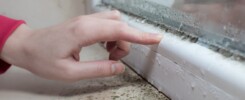Floods and storms in the Tampa area can wreak major havoc on your home. According to data from Accuweather, Tampa is one of the top five areas in the United States that are most vulnerable to hurricanes.
Whether it’s a massive storm or a minor one, flooding and water damage can result in various types of house mold.
Read on to learn more about the different types of mold that can occur in your home, and what you can do to protect your property.
Common Types of House Mold
Mold is a living thing, which means that many different species can be found inside homes. As for most mold growth in Tampa, there are three main types of house mold to be aware of.
These mold types include:
- Allergenic mold
- Pathogenic mold
- Toxigenic mold
Let’s break down each of these types of mold growth so you know what to look for. Water damage from flooding and storms can significantly increase the risk of one or all of these types of mold growing in your Tampa, FL home.
Allergenic Mold
Allergenic mold is the most common form of mold found in homes. While it’s not toxic, it can cause allergy symptoms and may trigger an asthma attack.
The type of symptoms you experience depends on how sensitive your body is to these mold spores. Some people experience no symptoms, while others experience much more intense symptoms and even severe reactions.
Sneezing and a runny nose are common symptoms of the presence of allergenic mold. You may also notice that you suddenly have watery or itchy eyes, or you might start coughing for an unexplained reason.
Pathogenic Mold
Although they’re less common than allergenic mold, pathogenic molds can cause an infection in healthy people and in those who are immunocompromised. This isn’t just toxic mold in homes — it can also grow on or inside of someone’s bodily tissues and organs.
If you inhale pathogenic mold spores or if you touch the mold with your skin, you can start to experience symptoms. People with weaker immune systems or certain pre-existing conditions may notice more severe reactions, particularly in children and the elderly.
Shortness of breath and ongoing, heavy coughing are some of the main symptoms of pathogenic mold. You might also get a skin or lung infection, and some people experience more severe allergic reactions than they would with exposure to allergenic mold.
Toxigenic Mold
The most dangerous form of mold is toxigenic mold, which typically spreads when a mold infestation is ignored, hidden, or when it isn’t handled properly and quickly. This mold is harmful to humans and animals, and it usually requires professional remediation.
Exposure to this type of mold can put yourself, your pets, and your family at serious risk. High-risk individuals might even experience serious complications like respiratory failure. Black mold is a good example of this toxic mold in homes.
The jury is still out on the severity of exposure to toxigenic mold. However, the CDC says that the link between conditions like memory loss or pulmonary hemorrhage and toxigenic mold is not conclusive.
How to Prevent Toxic Mold in Homes
While it’s impossible to prevent a storm from approaching Tampa, there are some things you can do to protect your home. Start fortifying your home before the storm hits by sealing all entry points including doors and windows. Look for worn-out or missing weather stripping and replace it as needed.
Make sure your roof is in good condition, and fix all leaks as soon as possible. Ensure that all of the shingles and flashing are in good condition to help prevent potential water damage.
During the storm, keep checking for signs of leaks and try to address them as soon as possible. If you have power during the storm, keep fans and dehumidifiers on to reduce the level of moisture and humidity in your home.
Once the storm has passed, remove any remaining standing water using buckets or a water pump. All building materials like drywall and carpet that have gotten wet should be removed within 24 hours to help prevent mold growth.
Throughout the year, try to keep the indoor humidity in your home at a level of 60% or lower. You can do this by keeping your air conditioner and/or dehumidifiers on as often as possible.
Make sure that your home has proper ventilation in areas like the laundry room, bathroom, and kitchen. Venting excess moisture to the outside will help to keep your home drier and ventilated properly. Inspect areas in your home prone to moisture regularly and seal any leaks or cracks.
More Ways to Prevent Mold Growth in Tampa
Aside from sealing gaps, checking on your roof, and addressing leaks, there are other things you can do to help prevent mold growth in Tampa in your home. First, consider using special mold-resistant products to protect the integrity of your property.
You can find mold-resistant paint, drywall, and sealants designed to inhibit the growth of mold and mildew. Use these products wherever you can to help protect your home from excess mold growth. Sealants should be applied around the tub, shower, and toilet as well as around the bottom of sinks to help protect them from moisture seepage.
It’s also recommended that you clean certain areas of your home as often as possible, including the bathroom and kitchen. Any areas where moisture is present should be thoroughly cleaned and dried to help reduce mold in homes. Clean your tub, shower, tile, and kitchen countertops with special mold-killing or mold-inhibiting products.
Protect Your Tampa Home
While these different types of house mold are a potential risk, there are things you can do to be proactive that will protect your Tampa home. From sealing gaps and fixtures to checking for roof leaks, the more you can do now to prevent water damage, the safer your home will be when a storm hits.
The amazing team at Big Easy Restoration can tackle Tampa water restoration from start to finish so contact us today to find out how we can help you.


